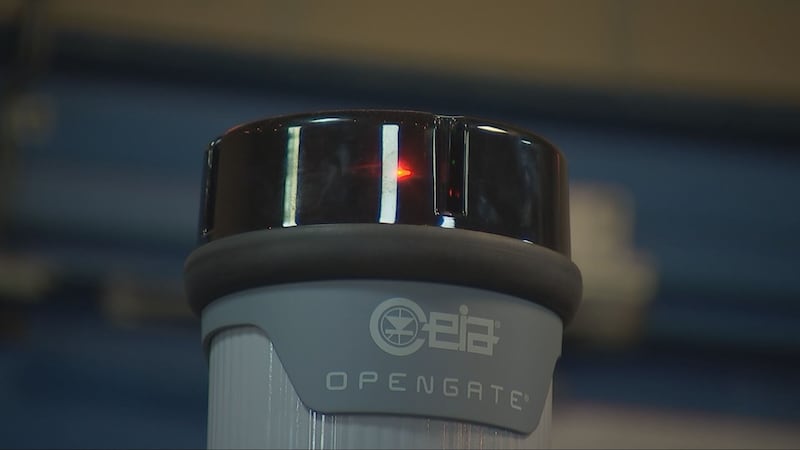Keeping students safe remains a top priority for public school districts across the country, but school security often doesn’t become a serious conversation until a crisis occurs.
While the National Center for Education Statistics reports that only 2% of public schools nationwide use metal detectors daily, 11 Investigates wanted to know how Western Pennsylvania public school districts compare.
No Central Data, So 11 Investigates Asked
There is no centralized database tracking which Pennsylvania schools use metal detectors.
“If the good guys know, so do the bad guys. It’s why you don’t post school floor plans online. For example, those kinds of things are intended to be private because it ties directly to the physical safety of students and staff,” Aaron Skrbin said, who is the Director of Safety and Security at the AIU.
In an effort for transparency without compromising that safety element, 11 Investigates surveyed all 99 public school districts in a five-county region to include Allegheny, Beaver, Butler, Washington and Westmoreland.
- 53 districts responded
- 37% reported not using any type of metal detection
- Of those that do use detectors:
- Nearly 50% have had them for more than a decade
- 24% added them in the last three years
- 28% added in the last five years
- 7% use newer weapon detection technology
“I know schools with metal detectors that have still had weapons get through,” Skrbin said. “They’re not a failsafe. But they can make people feel safer.”
A New Approach in Hempfield Area
For Hempfield Area School District, the past six months have brought a lot of change. Students now pass through OpenGate weapon detection systems — a shift prompted by a 2023 incident where three 15-year-olds were charged with bringing guns to school.
“Security is the most important thing in every school, in my opinion,” said Dr. Mark Holtzman, superintendent of Hempfield Area School District. “We live in a society where unfortunate events have occurred.”
Instead of traditional metal detectors, Hempfield invested in OpenGate systems that can identify weapons while reducing the institutional feel.
“Our students are more open to it and more comfortable. It’s more like walking through the front door,” Holtzman said.
What Other Districts Are Doing
At South Allegheny School District, Superintendent David McDonald said metal detectors are part of the everyday routine.
“We have a two-layer approach. All Grades 6 through 12 go through detectors, and if it beeps, they get scanned with a wand,” McDonald said. “We rarely have problems. Can we prevent everything? No, but [we can] have a plan in place to make sure we are doing the best we can for our families, school and community, that’s our job.”
However, not all districts follow suit. Among those without detectors, 74% said they don’t anticipate ever adding them, citing costs, staffing limitations and public perception.
“You’re really investing hundreds of thousands, maybe millions, into safety,” Holtzman said. “But I don’t think that priority is going away.”
Do Metal Detectors Work?
With all the money and time invested in these resources, 11 Investigates asks those school leaders if they believe the metal detectors work.
“Work is a broad answer or question because I don’t think anything is perfect. I think there is a chance that if someone wants to be harmful to young people, they are going to find a way to be harmful. But I think as a deterrent it’s fantastic,” Holtzman said.
“If somebody wants to come into a school and cause harm, they are going to be able to do it. I told you earlier our job is to be able to look at our families if something were to happen and say we’re prepared to protect your child,” McDonald said.
Safety and Security Big Picture
“The metal detector is just one piece of a much larger puzzle of safety and security; it is not the solution to all of our ills to society,” Skrbin said.
When you look at physical elements of school security, more districts are adding police officers, with South Allegheny adding two former McKeesport police chiefs alongside outside security, while the Hempfield area has a force of more than 15 officers that cover nine schools.
“I think having the experts in the building, the people who have seen it all. The people who know what to look for that are trained on what to look for. It’s critical with everything we’ve seen in schools in the last 20 years,” McDonald said.
Another new element to Hempfield is window decals, where the people inside the building can see out, but those on the outside can’t see in and it takes longer to break the glass.
“Is it perfect? No, there is no setting that is perfect, no arrangement that is perfect. A lot of things are just deterrents so people will not choose or decide to make bad decisions around schools,” Holtzman said.
Now add in evolving technology and many districts are adding artificial intelligence software to the camera system to detect hidden weapons and push buttons for staff to wear.
“That is a push button on an ID so a teacher can push a button three times and send out an immediate alert to our cell phones, we know right away if there is a fight or argument. A teacher can push that button eight times and it puts the building on an immediate lockdown and it notifies the local authorities,” McDonald said.
Relationships Play an Ultimate Role
New relationships are built through these daily routines, but ultimately, school leaders rely on those they hire to help keep everyone safe.
“Building the relationships is ultimately what keeps us safe. You could secure a building with all these physical security measures but if you aren’t talking about relationships and helping kids to find a place of belonging and helping them feel safe and cared for. You may be secure but you aren’t doing the other things I would say you may not be safe,” Skrbin said.
Download the FREE WPXI News app for breaking news alerts.
Follow Channel 11 News on Facebook and Twitter. | Watch WPXI NOW
©2025 Cox Media Group






